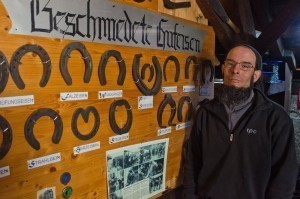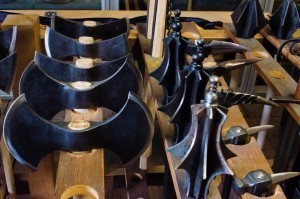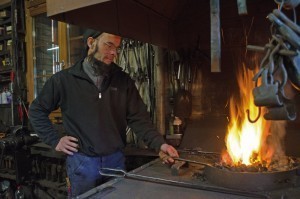In Huttwil, Switzerland, a young man is practising an even older craft in an old forge. The result is products that are so valuable that they are even inherited.
The house is one hundred and seventeen years old. The roof is pulled down low, supported by gray-brown bricks. In front of it, on artfully laid cobblestones, there are wagon wheels and horseshoes hanging above the door. The right-hand door leaf is carved. The carving reveals that in 1832 a certain Jakob Joss was the founder of a dynasty of blacksmiths who plied their trade here in Huttwil, Canton Bern, for four generations. The forge was built by the second generation in 1904 by a certain Adolf Joss.
100 years later, the current owner Reto Zürcher took over the property. Although he had previously trained as a blacksmith and farrier, during his apprenticeship he had almost exclusively worked as a locksmith. Zürcher: "Back then, blacksmithing was already a dying trade and my employer mainly made his turnover by cutting, welding and assembling. The few forging jobs that were commissioned were limited to the production of high-quality tools for workshops, railings and garden fences.
The real work came after work
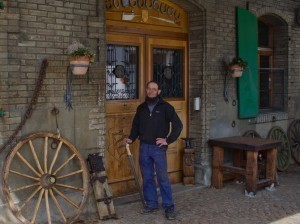 Zürcher armory. The building in the center of Huttwil is 117 years oldBut thatwasn't Zürcher's thing and his working life only began after work. He was then allowed to use the forge for his own private use and from the very beginning he forged edged weapons, i.e. knives and swords. "I was definitely inspired by my childhood, when I used to carve wooden swords for jousting games," he laughs.
Zürcher armory. The building in the center of Huttwil is 117 years oldBut thatwasn't Zürcher's thing and his working life only began after work. He was then allowed to use the forge for his own private use and from the very beginning he forged edged weapons, i.e. knives and swords. "I was definitely inspired by my childhood, when I used to carve wooden swords for jousting games," he laughs.
The fascination for knives and swords has remained. And when he later set up his own business, he put all his eggs in this basket and called himself "Waffenschmiede Zürcher"(www.waffenschmiede.ch). Today, he generates half of his turnover with edged weapons. A further 40% comes from farriery and Zürcher describes the rest as "regional".
The armourer finds his customers at the numerous medieval markets in the country, which he regularly visits with an exhibition stand.
His business is certainly helped by Switzerland's liberal weapons legislation, which does not consider sabres and swords to be weapons - in contrast to the legislation in other European countries. Zürcher smiles: "And then there are a few loopholes that can be used legally." In Switzerland, for example, everything that has to do with "throwing..." is prohibited. So throwing knives and throwing axes. However, as there are also many sports associated with such equipment (one discipline of the Highland Games is axe throwing, for example), it is possible to declare a throwing axe as a sports axe.
Zürcher's clientele therefore basically consists of sportsmen and women, people who revive certain eras (so-called re-enactment is a trend throughout Europe) and generally people who enjoy old craftsmanship and the individual design of objects.
The weaponsmith himself does not need to be very creative, as people's creativity was already fully developed in the past when it came to ways of killing other people. The medieval arsenal of terror included long weapons such as lances, spears and halberds, there were swords, sabres and swords, there were morning stars, clubs and battle axes as slashing weapons and the long-range weapons of bows and crossbows required arrows whose tips were capable of piercing chain mail or even the plate of a knight's armour.
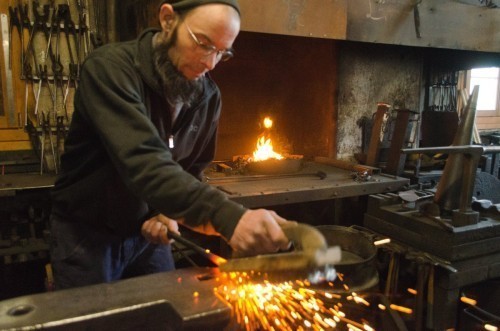 Now and again, a workpiece is brushed in an intermediate step. Then the sparks fly
Now and again, a workpiece is brushed in an intermediate step. Then the sparks fly
"The real first weapon of mankind was the sword. The bow and arrow were first invented in the Stone Age for hunting. The knife was for cutting and axes were for felling trees," explains Zürcher, showing a polished sword about one meter long. He then takes an intermediate axe and ice axe from a shelf, perhaps 40 centimeters long. "After man invented chain mail, swords became much less effective. Now you needed killing tools that were capable of penetrating chain mail, and that's what you did with claw axes like this." Another change in weaponry was the use of full plate armor. A man dressed in this way was confronted with a very short, pointed sword that was able to penetrate the cracks and crevices in the knight's armor, which were necessary at the joints so that a man in armor could move at all. Zürcher holds up the corresponding weapon.
25 types of steel for many applications
But it's not just medieval freaks who buy the right original weaponry from the Zürcher armory; many customers are chefs, for example, who want a high-quality kitchen knife. Zürcher forges these according to the customer's individual wishes and specifications. Factors include the length and shape of the blade, the material of the handle and the quality and finish of the metal.
Although Zürcher is a blacksmith, he always delivers a complete product. This means that the handle made of leather, wood, bone or antler is always already attached to the knife blade he produces. If you want a scabbard for a sword - no problem. Zürcher works together with a saddlery that produces a scabbard of the desired quality to match the sword.
Speaking of quality: the quality of a forged product naturally rises and falls with the type and composition of the steel. Zürcher has 25 different steels in stock, each of which is particularly suitable for a specific type of application.
Zürcher explains the differences using a knife as an example. The cheapest type of blade is made of mono-steel. He usually uses 1.2510 steel, which is optimized for use as a knife blade. This means that the steel offers a good compromise between hardness (i.e. edge retention) and robustness (i.e. toughness) of a blade. Both properties are necessary. The higher the carbon content of a steel, the harder and more edge-holding it becomes, but it is also brittle and prone to breakage.
The laminate method combines two steels with different properties. Put simply, a hard steel core is forged into a sheath (i.e. two layers) of a soft type of steel. The soft (elastic) jacket protects the hard (cutting) core, so to speak.
The supreme discipline of the blacksmith's art is the third way of forging a blade: a Damascus blade. As with the laminate solution, two steels, one hard and one tough, are forged together, but not just the three layers soft - hard - soft. Zürcher: "A good Damascus steel should have at least 45, but no more than 250 layers. The number of layers influences the folds and patterns."
Regardless of the type of forged product, when it comes out of the fire, the surface must be treated. Because the piece is black and unsightly. The first step is to polish it. This starts very roughly with a coarse abrasive belt. Once the heavy residue has been removed, the sanding belt becomes finer. Zürcher's trademark, however, is to leave the original black forged surface as a decorative element in some places. The finishing touches are applied later using polishing paste and a soft brush.
Here too, Damascus steel requires special treatment. It is first roughly polished and then etched in iron(III) chloride. Later, it is neutralized in an alkaline solution before being polished again, this time using finer methods.
Regardless of the type of blade, axe or the tip of a long weapon, the sharpness is honed after forging. All of the blacksmith's products are made to last a lifetime and are so valuable that in many cases they will be enjoyed by future generations.
It is clear that quality and craftsmanship have their price. As a guide, a kitchen knife made from mono-steel starts at around 300 francs, a laminate steel knife at 450 francs and a knife made from Damascus steel is available from 850 francs.
All photos: Heinz Käsinger


